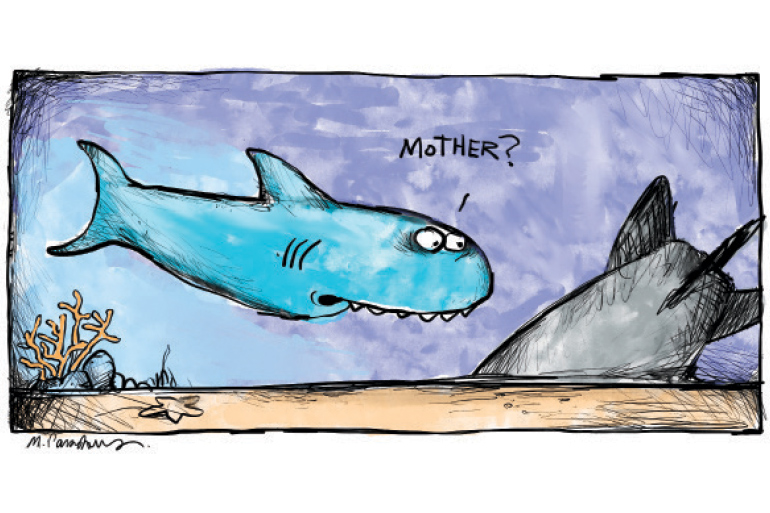Drama at Sea: Torpedoes, 'A Speck in the Sea' and the Pink & Purple Dragger

Every day, weather permitting, the fishing trawlers go out from Shinnecock and Montauk in search of porgies or pollock, flounder or bluefish or whatever else is running. Onboard usually are a captain and a mate or crew. They often leave at 5 a.m., as dawn rises. When they get to the fishing grounds, they crank out the 40-foot-long steel outriggers and lower the nets, then steer the ship so the nets fill with fish. After that, the nets are brought alongside the ship, and the fish are taken aboard and dropped into the hold. The crew usually gets back with a boat full of fish at about 3 p.m., tired but a little bit richer. It’s a living.
You might think not much would go wrong on these trips. But it does. A survey by the U.S. Bureau of Labor Statistics ranks commercial fisherman as having the second most dangerous job in America. Number one is logging workers. Third, fourth and fifth are pilots and flight engineers, roofers and steel workers. During 2013, Stian Stiansen, a fisherman from East Quogue, drowned when his fishing boat capsized off Shinnecock. There have been other events, which will be reported upon further down in this article. But there have also been three offshore dramas that have riveted the Hampton Bays and Montauk fishing communities.
The first of these took place in 1991, when the Coast Guard ordered the entire southern half of Hampton Bays evacuated for half a day because of what Captain Hand and his mate aboard the trawler Shinnecock had caught.
The second event took place on July 24, 2013, some 40 miles off Montauk. Around 9 p.m., Anthony Sosinski, the co-owner of the lobster boat Anna Mary, went below to take a two-hour nap, leaving his partner, John Aldridge, on deck to take care of things, the boat on autopilot. When Sosinski awoke just after dawn, it was long past the two hours he intended to sleep. And Aldridge was nowhere to be found. What happened? The 12 hours of drama that followed became a book and is currently in the process of being made into a movie.
The latest sea drama involves Captain Rick Lofstad, his mate Desmond and his Hampton Bays trawler, All for Joy, fishing near Fishers Island last week. The ship got caught in a storm, lost its hatch cover when a wave washed across the deck, and it began to wallow low in the sea as the hold began to fill with water. Lofstad (whose father was Stian Stiansen) called the Coast Guard for help, and when they arrived they found All for Joy, a dragger painted pink and purple, rolling in the stormy seas in great distress. The Coast Guard ship pulled through the 10-foot surf to come alongside and, after a crew member tossed them a baling pump to try to clear out the water, proceeded to escort the All for Joy for the next two hours to reach the calm waters behind Fisher’s Island.
They never made it. The All for Joy, with the pump unable to keep up, got lower and lower in the water and finally, when it seemed inevitable it would turn upside down in the heaves of the surf, the Coast Guard radioed Lofstad and Desmond to abandon ship. They put on the required neoprene wetsuits that all commercial ships now have. And just moments before the All for Joy turned over, they jumped, splashed around and were soon hauled aboard the Coast Guard vessel, where they were wrapped in blankets.
During the effort to save the ship while the pump was going, Lofstad asked the Coast Guard captain over the radio if he wanted to know why his ship was painted pink and purple. He said, according to The Southampton Press, that when his daughter, Joy, was three years old, he’d asked her what colors to paint the ship, and she said pink and purple. So he did. He later said in The Southampton Press that he wanted them to know this in case he didn’t make it.
The All for Joy floated for a short time in the sea and, not long after that, sank. But the crew lived to tell the tale. The commercial fishermen in Hampton Bays are still talking about this.
As for the terrifying event in 2013, when Anthony Sosinski woke at dawn instead of 11:30 p.m., he ran up top to talk to Aldridge about his failure to wake him and—where was he? The seas were calm and the ship was still on autopilot. And there was no Aldridge.
Frantically, Sosinski radioed the Coast Guard. One of the first things they asked, he later told people, was did he leave a suicide note? In any case, they were on their way from their base in New London. Sosinski soon noticed a 35-gallon Coleman ice chest cooler with a handle broken off. It had not been broken off before. It must have given way, he thought, while Aldridge was pulling on it, heaving Aldridge over the side.
Sosinski noted the speed of his boat and the direction the autopilot was taking them, and made a line on a chart that showed the path the ship was taking when Aldridge went overboard. He turned the ship around to go back along it. Soon, airplanes and more Coast Guard ships were on their way, and also almost the entire fishing fleets from Montauk, Connecticut and Rhode Island. Even Jimmy Buffett, who keeps a yacht at Sag Harbor, was out there.
How long could Aldridge last at sea? Twelve hours into the search, Aldridge was seen sitting on a rope between two lobster buoys he had come upon, which he had tied together. Rescued from there, he told his story. He had not been wearing a life jacket when he had been heaved into the sea. But he had heavy rubber boots on, and by reaching down after falling off the ship, he was able to take them off, hold them over his head upside down to get the water out, and then use them under his armpits for floatation. What a story that was. And again, there were celebrations throughout the fishing community at this close shave.
After they were back and safe, they were encouraged to write a book about the experience. It became A Speck in the Sea, and soon thereafter it was picked up to be made into a movie by the Weinstein Brothers (pre-all Harvey’s troubles.) Today, two years later, it still hasn’t been finished. We will just have to wait and see.
The 1991 event involved a dragger called the Shinnecock I, owned by the legendary Captain Daniel Hand of Hampton Bays. It had been an uneventful day of fishing 45 miles off in the Atlantic, until Hand and his mate hauled in a net full of porgies that also included what looked like a very old World War II unexploded bomb or torpedo. Hand might have decided to cut the net free from the boom and let it drop down to the sea bottom, but that would have been a waste of a good net, the loss of a load of porgies and perhaps the losing of an important war relic, and so he left everything where it was under the boom and headed home. What happened next is the stuff of legend.
Approaching the inlet, he radioed in to shore describing what he had—in prior years, fishermen had caught hand grenades, poison gas canisters and cannon balls—and about 20 minutes later, a new call came in to him. A description of what he had hauled up had been forwarded to munitions experts in Woods Hole. He was carrying a torpedo with 800 pounds of explosives in the nose, which if still dry, could blow up at any minute.
“Head back out to sea a half a mile,” he was told over the radio. “And drop anchor. We will come and rescue you.”
That rescue came by helicopter. As the legend has it, the 106th Air National Guard in Westhampton had been called in—this is a para-rescue unit that serves the entire Western Hemisphere—and they hovered over the Shinnecock, dropped a rope ladder, sent two para-rescuers down and helped the captain and his mates up and off.
Hand and his mates were taken to shore, only to find the entire boatyard, dock and nearby community abandoned. Everyone had been ordered inland from the shorefront. Nobody was taking any chances.
Not long after, the Navy sent out a ship, the sailors climbed aboard the Shinnecock I, set some charges around and set them off by remote control, which sank it. But there was no torpedo explosion. Some days later, divers went out, located the torpedo to try to disarm it, but it still wouldn’t explode. It seems to have been a dud. From Daniel Hand’s perspective, though, it didn’t matter much.
The Navy said the government would pay him to replace the fishing boat. But time passed and then more time, and the Navy wasn’t paying him. This was amazing and it became a scandal. Then the media got involved.
At Hand’s home on Vail Avenue in East Quogue, Daniel Hand was spending his days watching television.
“Basically,” his wife told reporters, “we’re on hold. The Navy blew up his life. He’s got nothing left. No job. No boat.”
In the end, it took efforts by our local Congressman George Hochbrueckner, along with Senator Alfonse D’Amato, to finally squeeze $220,000 out of the Navy, enough to help Hand to buy a new Shinnecock II, for about $300,000, he estimated, provided he mortgaged his house.
Captain Hand fished off his Shinnecock II for many years thereafter.



